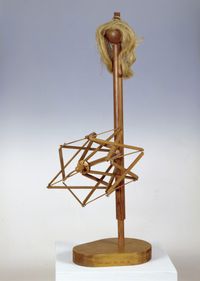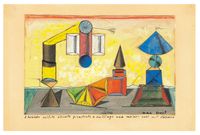German artist Max Ernst was one of the founders of the Surrealist and Dada movements. He worked in a range of media including painting, collage, sculpture, and frottage (a method of taking pencil rubbings from uneven surfaces).
Read MoreErnst developed the Surrealist techniques of frottage and grattage, and is well known for his collage novels and artist books.
Ernst was born in Brühl, Germany. One of nine children, Ernst was interested in art from a young age. His father was an amateur painter, who inspired him to sketch and draw frequently.
In 1909 Ernst enrolled at the University of Bonn to study philosophy. Not long after, he decided to leave the course to focus on his interest in art. In 1911 Ernst befriended August Macke and joined the Rheinische Expressionisten group.
In 1912 Ernst showed his work for the first time at the Galerie Feldman in Cologne. He became greatly influenced by Pablo Picasso, Paul Cézanne, and Vincent Van Gogh after seeing their work at the Sonderbund exhibition in Cologne that same year. A year later, Ernst met French artist Robert Delaunay and travelled to Paris. In 1914 he became friends with Jean Arp, a German artist known for his Dadaist art.
A founder of the Surrealist and Dada movements, German artist Max Ernst worked in a range of media, including painting, sculpture and collage. The artist was closely affiliated with artists André Breton and Paul Éluard.
Max Ernst's artworks consider themes of mythology, childhood nostalgia, and Freudian metaphors.
In this series of paintings, Ernst depicts windswept creatures tangled up with one another. The creatures appear to be half-bird and half-human and refer to the artist's personal mythology, wherein the birth of his sister coincided with the death of his family's pet bird.
'The Horde' (1927) paintings are richly textured and express the wide range of techniques Ernst explored during this period. The artist's original method of grattage can be seen in the lower section of the painting. The scraping of paint gives the artwork a depth of texture that evokes a dark atmosphere.
Europe After the Rain (1940–1942) depicts a surreal landscape that evokes an apocalyptic state. Although the painting is reminiscent of classical style, the anthropomorphic figures and devolved scenery portray a haunting image of what civilization could be.
The painting is an uncanny representation of how the destruction of the Second World War affected the continent of Europe. In 1940, Nazis condemned Ernst's artistic practice as degenerate. He was interned in a prison camp in France, where he began working on Europe After the Rain. He finished the painting in 1942 after escaping to the United States.
The Dadaist movement of the 1920s saw collage as a way to explore art beyond the realms of painting. Ernst began to experiment with collage from as early as 1919.
A Week of Kindness (1934) is an intricate collage novel that Ernst created by cutting up and rearranging illustrations from scientific journals and 19th-century novels. Ernst's collage conveys a surreal narrative of bourgeois characters transformed into monstrous creatures.
Ernst's collage is dark and humorous. It plays with themes of violence, repressed sexuality, and anticlericalism while extending the boundaries of what art could be in the 20th century.
In 1954 Ernst was awarded the Grand Prize for painting at the Venice Biennale.
Ernst's work is featured in the collections of Guggenheim Museum in New York, The Metropolitan Museum of Modern Art in New York, Tate Gallery in London, the Art Institute of Chicago, the Thyssen-Bornemisza Museum in Madrid, and the Museo Reina Sofía in Madrid.
Max Ernst's artworks have been exhibited extensively around the world in important solo and group institutional exhibitions.
Notable exhibitions include De Chirico, Max Ernst, Magritte and Balthus: A Look Into the Invisible, Palazzo Strozzi, Florence (2010); Picasso et ses amis, Galerie für Kunst von Picasso, Dusseldorf (2009); Max Ernst – The Illustrated Books, The National Gallery of Art, Washington, D.C. (2008); Max Ernst: Ballade du Soldat, Scottish National Gallery of Modern Art, Edinburgh (2007); Max Ernst: A Retrospective, The Metropolitan Museum of Art, New York (2005); The Proper Meaning, Zwirner & Wirth, New York (2001); Max Ernst – (Brühl 1891–1976 Paris), Galerie Boisserée, Cologne (2001); and Max Ernst: 1891–1976, Museum of Modern Art, New York (1976).
Other group shows include The Sylvio Perlstein Collection A Luta Continua, Hauser & Wirth, Hong Kong (2019); The Secret of Things. Painted Pieces, Beck & Eggeling International Fine Art, Dusseldorf (2018); Endless Enigma: Eight Centuries of Fantastic Art, David Zwirner, New York (2018); and A Luta Continua, Hauser & Wirth, New York (2018).
Phoebe Bradford | Ocula | 2021






